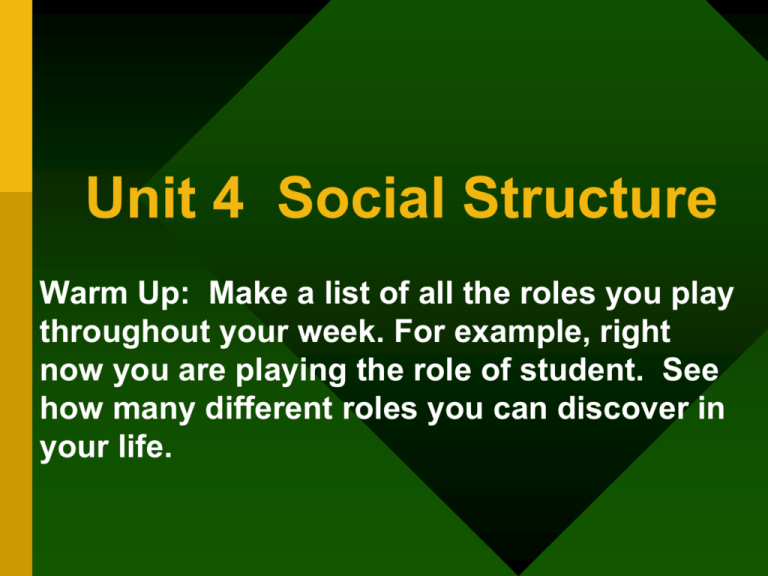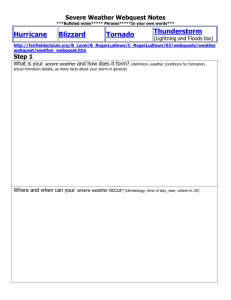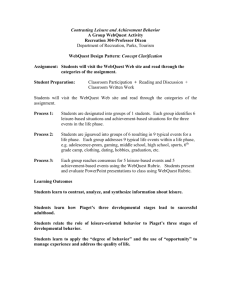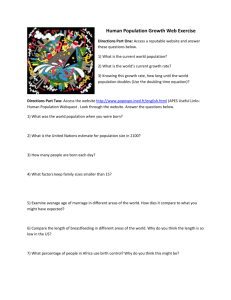Unit 4 Social Structure
advertisement

Unit 4 Social Structure Warm Up: Make a list of all the roles you play throughout your week. For example, right now you are playing the role of student. See how many different roles you can discover in your life. Status Social Structure – network of interrelated statuses and roles that guide human interaction Status – socially defined position in a group or society. Role – the behavior, rights and obligations expected of someone occupying a particular status. Status Ascribed Status – based on a person’s inherited traits or are assigned automatically when a person reaches a certain age ( i.e. – son or daughter, teenager) Achieved Status – acquired through effort and includes special skills, knowledge or abilities. Alfonso Soriano Status Master Status – this status plays the greatest role in shaping a person’s life and determining his or her social identity. Master status may be ascribed (King) or achieved (teacher, CEO) Roles • Roles – parts we play in life. • Reciprocal Roles – you have a counterpart in this role: Parent/Child, Husband/Wife, Teacher/Student, etc. • Role Conflict – the duties of one role conflict with the duties of another role. Status and Roles Go back and look at the list you made for the warm up. Draw yourself wearing several hats. Each hat will represent the different roles you play as a part of your master status and ascribed status. Label the hats with the role it represents and whether it indicates master status, ascribed status or achieved status. Types of Social Interaction • Reciprocity – if you do something for someone, they owe you something back. • Competition – two or more people oppose each other to achieve a goal only one can attain. • Conflict – attempt to control a person by force. • Cooperation - people work together to attain a common goal (completion of the webquest.) • Accommodation – you give a little, you take a little (i.e. compromise) Types of Societies - Preindustrial • Hunting and Gathering Societies – before agriculture (nomadic, simple tools) • Pastoral – sheep herders, etc. (nomadic, complex tools) – some division of labor • Horticultural – agricultural, complex tools, settled villages. • Agricultural – larger cities and populations, complex technology and social structure, trading and barter Types of Societies - Industrial • Emphasis shifts from food production to production of manufactured goods. • Population size increases because of increased food production • Urbanization – move from farms to cities. Types of Societies - Postindustrial • Much of the economy is involved in provided information and services. • Standard of living and quality of life improve as wages go up. • Rights of individuals and personal fulfillment become more important. Groups within Society • Groups have four major features: 1. Consists of 2 or more people 2. Must be interaction among members 3. Members have shared expectations 4. Possess some sense of common identity Groups within Society Types of Groups 1. Primary Group – Small group which interacts over a long period of time. Each individual matters deeply. (family) 2. Secondary Group – Interaction is impersonal and temporary. (small group in a class room) 3. Reference Group – People usually perform their social roles and judge their own behaviors according the standards set by a particular group. (Religion) 4. In Group – Group a person belongs to. (Us) 5. Out Group – Group a person does not belong to nor identify with. (Them) 6. E-Communities – Virtual communities (MySpace) 7. Social Networks – Web of relationships formed by the sum total of a persons interactions with other people. Groups within Society Make a list of the groups to which you belong. Then, find another person in class who belongs to three or more of the same groups you do! Write down their names in your notes. Graphic Organizer: Characteristics of Bureaucracy Characteristic Definition Division of Labor Ranking of Authority Employment based on formal qualifications Rules and Regulations Specific lines of promotion and advancement Example Field Study: Webquest • The field study this time is a webquest. • The title is “Logging On and Fitting In – A Sociological Field Guide to Virtual Communities” • The web address is http://webquest.org/questgarden/lesson s/30260-060713082731 • You will have one extra class day to work on this. Warm Up: September 27, 2006 Continue with your Field Study: Webquest. There is a quiz over Unit 4 at the end of the period. • The field study this time is a webquest. • The title is “Logging On and Fitting In – A Sociological Field Guide to Virtual Communities” • The web address is http://webquest.org/questgarden/lesson s/30260-060713082731 “Logging On and Fitting In – A Sociological Field Guide to Virtual Communities” Some sociologists have suggested that computer technology – most notably the internet – has given rise to a new type of group. In an e-community or virtual community, people interact regularly with one another on the internet, often through the use of newsgroups. Most newsgroups are little more than sites for members to discuss issues of common interest. However, some seem like primary groups. Members exhibit behaviors similar to those of real world primary groups. They argue, engage in intellectual discussions, exchange knowledge, share intimate details of their lives, and even form romantic relationships. “Logging On and Fitting In – A Sociological Field Guide to Virtual Communities” In this webquest, you will explore some of the virtual communities of the 21st Century, a new and growing social "group. " In teams of four, you will each investigate one aspect of the virtual world. One sociological fundamental is the idea of the "group." A "group" is composed of people who share several features; including regular contact with one another, a shared way of thinking and feeling, common interests and a genuine concern for each other and one another's behavior. Before the internet, groups were primarily the family, the workplace or school, and the general community. In the 21s Century, groups now must include all of those increasing interactions people have with one another online. In his book The Virtual Community (1993), Howard Rheingold first brought the world's attention to the idea of virtual, or E-communities: “Logging On and Fitting In – A Sociological Field Guide to Virtual Communities” "The idea of a community accessible only via my computer screen sounded cold to me at first, but I learned quickly that people can feel passionately about e-mail and computer conferences. I've become one of them. I care about these people I met through my computer, and I care deeply about the future of the medium that enables us to assemble. . . . Finding the WELL (an early e-community), was like discovering a cozy little world that had been flourishing without me, hidden within the walls of my house; an entire cast of characters welcomed me to the troupe with great merriment as soon as I found the secret door. Like others who fell into the WELL, I soon discovered that I was audience, performer, and scriptwriter, along with my companions, in an ongoing improvisation. A full-scale subculture was growing on the other side of my telephone jack, and they invited me to help create something new."



